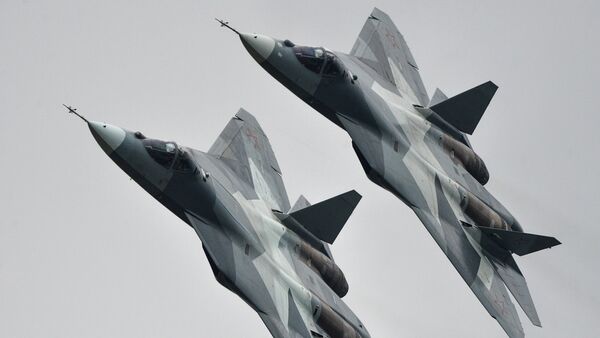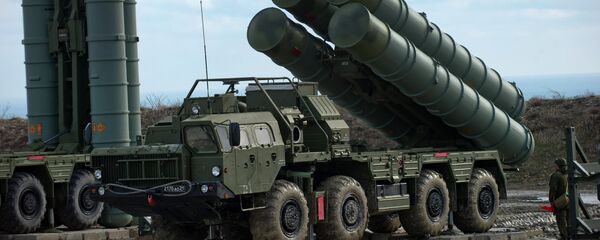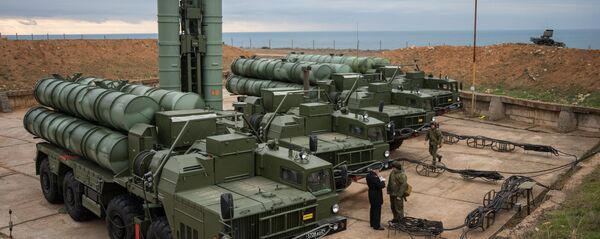Washington is seeking to expel Russia from India and Southeast Asia's weapons markets by unfair means, Rakesh Krishnan Simha, a journalist, foreign affairs analyst and military observer, told Sputnik, referring to the US's Countering America's Adversaries Through Sanctions Act (CAATSA).
"The Americans are trying to create a monopoly situation by using an illegal law to shut out Russian arms manufacturers from the arms market," the military observer stressed. "This is not good for anyone as the US will then dictate terms and price its weapons any which way it wants."
Simha opined that the CAATSA is nothing but "an illegal attempt to slow down Russian arms exports because according to the World Trade Organization (WTO) no country can pass laws to restrict free global trade."
"The US is the biggest weapons exporter in the world, surpassing even Russia, which is ranked second by a wide margin. So it's not about competition, but an attempt to increase the scope of sanctions, which have failed to bring down the Russian economy," the journalist said, adding that laws like CAATSA were adopted by Washington "in response to Russia's resilience in the face of sanctions."
On July 18, Defense News reported that a number of top US lawmakers and US Defense Secretary Jim Mattis were seeking to fix the CAATSA, arguing that the law "imperils America's alliances and access to defense markets in the Indo-Pacific region."
On July 24, a Congressional committee proposed a special waiver that would allow India to purchase the Russian-made S-400 air defense system and escape sanctions. The Russian-Indian agreement for the acquisition of S-400 complexes was concluded by Moscow and New Delhi in 2016.
Still, the proposed measure is aimed at "[encouraging] allies and partners to reduce inventory of Russian-produced major defense equipment and advanced conventional weapons," according to the US Senate Arms Services Committee.

Russia's Primary Competitive Advantage
According to the journalist, Russia's primary competitive advantage "is the high quality of its weapons at a great price."
To illustrate his point Simha noted that the Sukhoi Su-30, the world's second most capable 4th generation fighter-bomber after the Su-35 warplane, costs $65 million while the Dassault Rafale, a multirole fighter aircraft, is priced at approximately $244 million.
"To be sure, such a simple price comparison is not helpful because the two aircraft are built for different types of missions and belong to different eras," the military observer admitted. "The Rafale brings a whole new suit of technologies and missiles along with it and these technologies are going to be grafted on to Indian-built jet fighters. However, in a one-on-one dogfight there is no doubt that the supermaneuverable Sukhoi will blow the French fighter out of the air within seconds. Most countries will do just fine with the cheaper Sukhoi than the Rafale."
In addition, the latest Sukhoi and MiG aircraft "can take off and land on unpaved runways whereas Americans carefully do a manual sweep of the runways because even the smallest piece of stone can screw up an F-15 or F-16," Simha pointed out.
Russia Has Long Record of Arms Supplies to Asia
The journalist recalled that during the Soviet era Russia "was almost the sole provider" of weapons to India.
"According to a Royal United Services Institute [Chatham House] report titled 'India's New Armament Strategy: A Return to Self-Sufficiency?,' by the end of the Cold War, India was 100 percent dependent on the Soviet Union for ground air defense; 75 percent for fighter aircraft; 60 percent for ground attack aircraft; 100 per cent for tracked armored vehicles; 80 percent for tanks; 100 percent for guided missile destroyers; 95 per cent for conventional submarines; and 70 percent for frigates," he emphasized.
However, small Southeast Asian countries, such as Vietnam, are currently reluctant to shift from Russian-made arms to expensive Western weapons, as they are not as rich as India or China, the military observer remarked.
According to Chatham House, Asia has accounted for 70 percent of Russia's arms exports since 2000, with India, China and Vietnam being the "principal sources of demand." The nonprofit organization highlighted that between 2000 and 2016, Russia's sold 43.1 percent of all the weapons exported to the region. For comparison's sake, over the same period Washington accounted for just 24.6 percent of arms sales to Asia.
Why Trump is Not Interested in Losing India
The journalist believes that the Trump administration will take further efforts to soothe disputes with India, despite New Delhi's refusal to abandon its longstanding allies — Russia and Iran.
Simha noted that given India's huge market and military prowess, Trump, a businessman, is unlikely to risk losing such a partner.
"Trump has upset a lot of his allies such as Germany by his harsh words but that doesn't mean Berlin is quitting NATO. Similarly, if Trump gets acrimonious with India, there will be name calling by some political leaders and the media in India but any further deterioration of Indo-US ties is highly unlikely," the journalist concluded.
The views and opinions expressed by the contributors do not necessarily reflect those of Sputnik.






